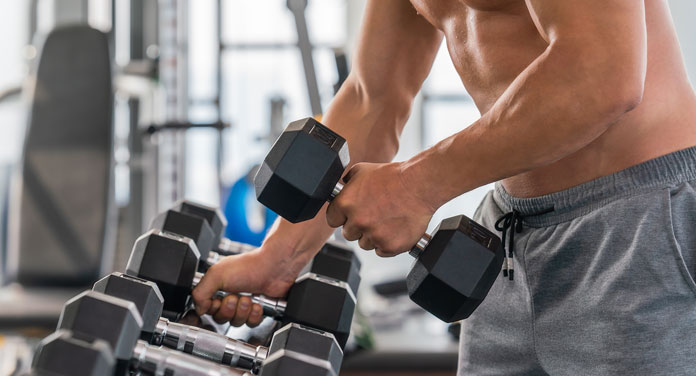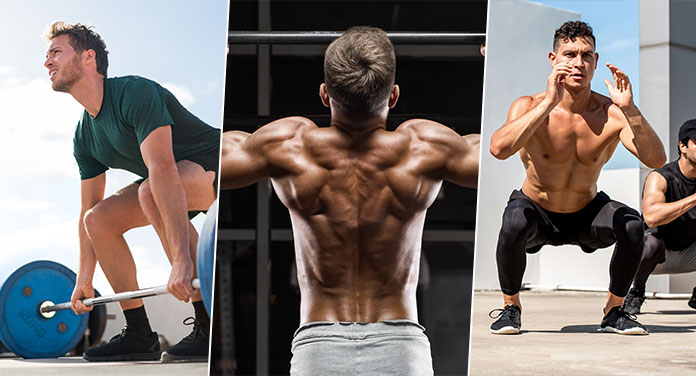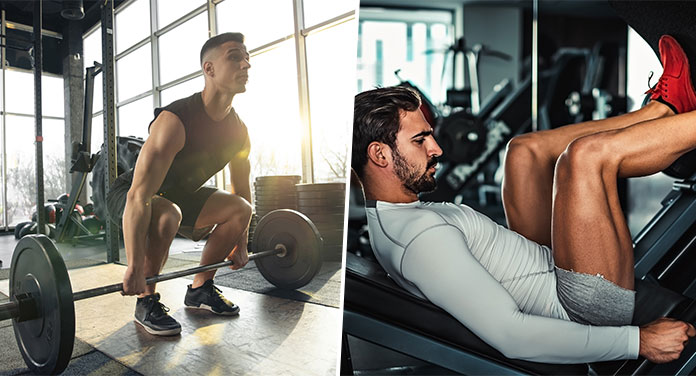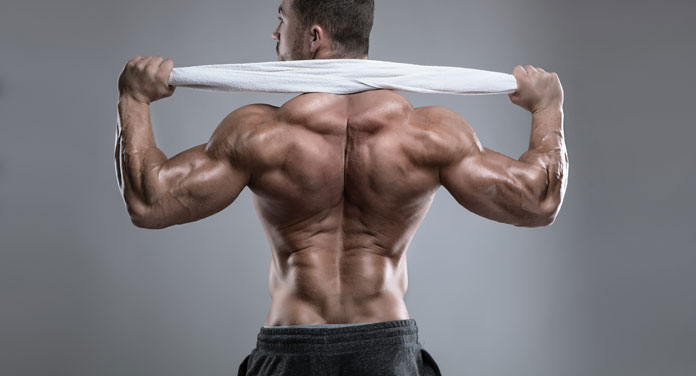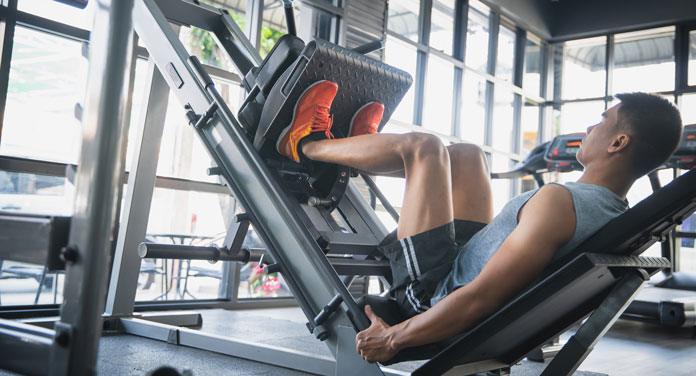Dumbbell Exercises At Home ❚█══█❚ Handy, demanding, and encouraging: This is how a dumbbell should be, which was still called a haltere in ancient Greece. It is considered a functional training device that brings you effectively and efficiently to your training goal. We’ll show you how it works and show you seven dumbbell exercises you can do at home that will help you build big arms.
In contrast to strength machines, when training with dumbbells, the body has to use many auxiliary or stabilizing muscles, which are particularly located in the torso area. In order to be able to build up the main players of the article, the arm muscles, relatively quickly and sustainably, you should heed a few training principles and practical tips.
Training Principles For Our Dumbbell Exercises
Basically, there are many different training principles for muscle building. Here we explain two principles that are extremely effective in practice:
Principle Of The Effective Stress Stimulus
If you train and proceed in a planned, systematic, and sustainable manner, the training stimulus must exceed an individually strong intensity threshold so that physiological and anatomical adaptations can occur. The stress stimulus depends on your training status and your body’s adaptation reactions.
In practice, this means that your body has to recover for about one to three days after training. During this time, adaptation processes such as repairing muscle tears, regeneration, and building of muscle tissue take place. The training effect can be quantified if, during the next training session, you B. you can do more repetitions in your training.
Principle Of Progressive Loading
The second principle is closely linked to the principle of the effective stress stimulus. An effective stress stimulus does not only occur once but must be repeated in small steps or later in large steps. Training loads that are identical over a longer period of time do not lead to any further increase in performance or build-up of muscle mass.
In training practice, it has proven useful to first increase the number of training units per week. The scope of training within the training unit (the number of training exercises) is then expanded and ultimately the training intensity is increased. Optionally, you can also shorten the rest time between sets.
Progressive Overload
A particularly effective way of muscle training is progressive overload. The principle: the stronger you get, the more effectively you can build muscle. Progressive overload is based on the above training principles and common training methods.
A mix of compound exercises and isolation exercises, as part of a progressive overload, will produce the best muscle-building results. Ideally, the basic exercises are performed in the repetition range of 3 – 6. This corresponds to the training method strength training. Isolation exercises, which you should always use towards the end of the training session, are performed in the so-called hypertrophy range (enlargement of the cross-section of the muscle fibers) of 6 to 12 repetitions.
Now how should you proceed practically? If you’re looking to train smaller muscle groups like arms and shoulders, ideally start with an increase of 5-10 lbs. Larger muscle groups (e.g. in the legs) can also be stimulated in 5-10 kg increments. At some point, an increase in weight is no longer possible, so stagnation occurs. Then other parameters such as the number of repetitions and sets or alternative training methods count.
Dumbbell Training – The Most Important Things In Brief
A stable posture and body awareness are important when training with dumbbells. In addition to coordination, the following execution elements of an exercise are crucial:
- Warm-up: Before each training session, you should warm-up and mobilize yourself sufficiently (approx. 5 – 10 minutes).
- Start with complex exercises and slowly work your way up to isolated exercises.
- Beginners start with 5 – 10 lb and 12 – 15 repetitions or 2 – 3 sets (adaptation and familiarization phase during fitness training), advanced users can start with 10 – 50 lb and 3 – 6 repetitions or 3 – 5 sets. Pros automatically adjust their weights, reps, and sets to their skill level.
- Length of breaks: Beginners take a break of about 60 seconds, advanced and pros 60 – 120 seconds.
- Beginners should train for about 6 – 8 weeks according to the above scheme and gradually switch to the advanced mode in order to build muscle mass over the long term.
- Rule of thumb: Effective training means that you make sure that the last repetition of an exercise is as technically correct as possible.
- A deflection during training is quite possible at a higher training level if muscle and joint structures are not intentionally damaged. This is e.g. This is the case, for example, if the full range of motion is not used during an exercise or if an isolated muscle group is to be addressed. For beginners, deflecting an exercise is anything but advisable because injuries and damage are inevitable.
7 Dumbbell Exercises To Do At Home
Below we present 10 dumbbell exercises that are primarily intended to focus on muscle growth in the arm area, but also on larger muscle groups. In addition, there is one exercise variation each.
Bench Press With Dumbbells
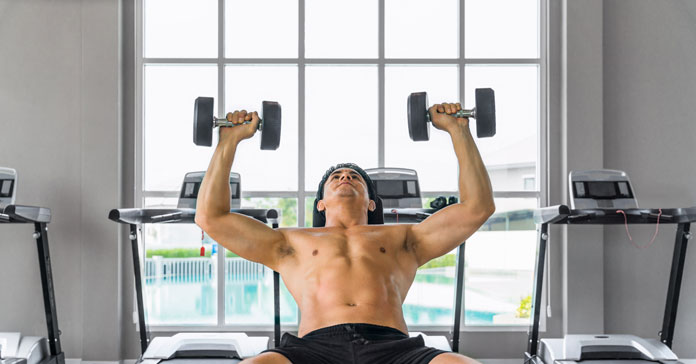
Target muscles: Arm extensors and chest muscles
Take a dumbbell in each hand. For body stability and ergonomics, initially hold the dumbbells at an acute angle close to your upper body so that one dumbbell plate is pointing up and one down. Now lie down on a weight bench or wide stepper, align your arms to the side at right angles so that on the one hand the elbows are under the shoulders at about the height of the breastbone and on the other hand the dumbbells are technically perfectly moved by a stable grip of the fixed wrists be able.
Now raise the dumbbells in an arch and pyramid shape until just before arm extension and almost touch the dumbbells and hold for a moment. Then lower the weights in a controlled and synchronous manner to the starting position so that a small stretching stimulus is created in order to ensure the largest possible range of motion and to optimally stimulate the target muscles.
Variation: In order to control the arm extension (triceps) more specifically, you can turn your wrists and elbows inwards (middle of the body) and reduce the distance between the dumbbells. The “tight” version shifts the focus more to the arm muscles.
Hammer Curls
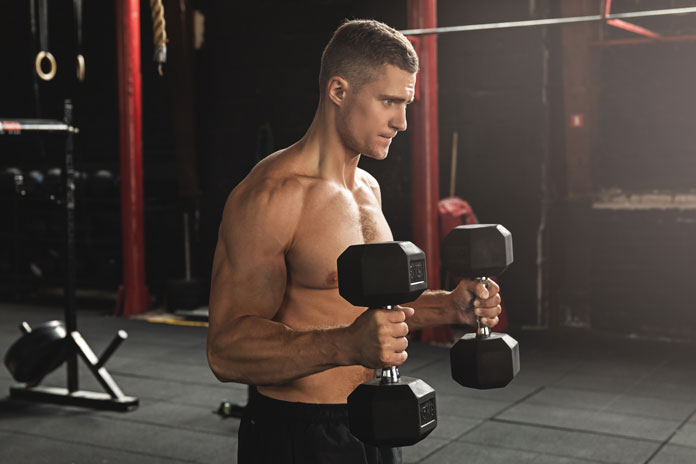
Target muscles: biceps, humerus, humerus radius
In this exercise, you stand shoulder-width apart. Your arms are at your sides in a slight bend. Palms and grip face towards the body. Now the forearms are alternately bent towards the sternum without turning your palms. Your upper arms remain in the starting position. Then bring your arms back to their original position in a controlled manner. In many cases, the quality of execution can be improved by fixing the elbows to the body.
Variation: The cadence (the tempo of the exercise), e.g. 1st set: fast flexion, slow extension, 2nd set: slow flexion, fast extension, 3rd set: slow flexion, slow extension, can improve the training stimulus and body feeling of the flexor muscles in hammer curl.
Shoulder Press With Dumbbells
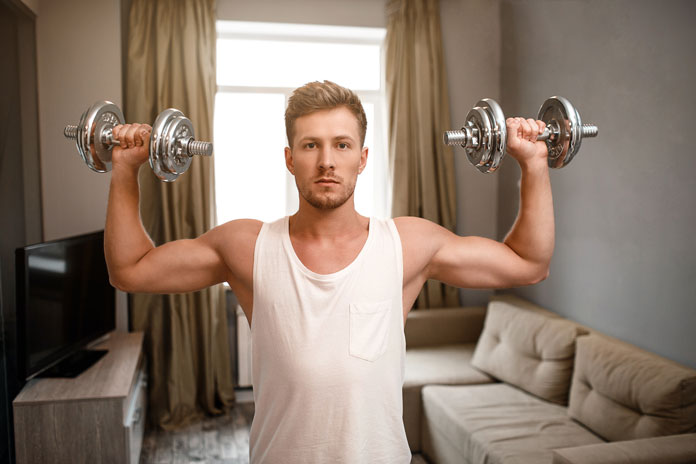
Target muscles: Arm extensors and shoulder muscles
Sit on a weight bench or stool, each with a dumbbell, with your arms bent at shoulder height. The elbows are rotated slightly forward and the dumbbells are at head height. Now stretch your arms upwards in a pyramid shape with a slight body tension until the dumbbells almost touch each other overhead. You should hold this position briefly and then return to the starting position in a controlled manner.
Variation: This exercise becomes a little more challenging if you do it standing up with a slight bend in your legs and core contraction.
One Arm Rowing
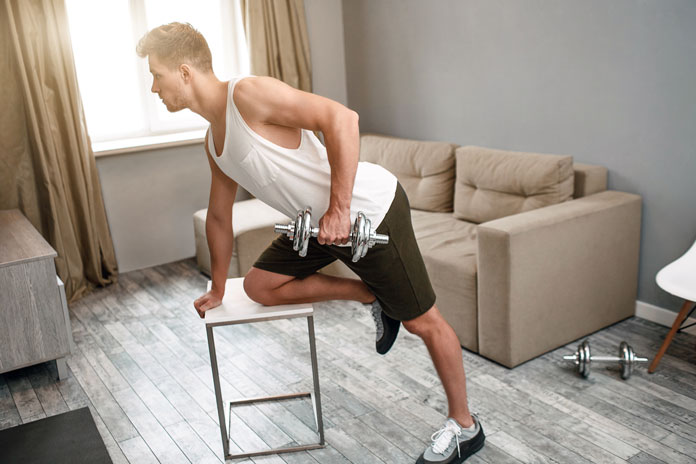
Target muscles: Biceps, Latissimus Dorsi, Posterior Deltoid, Trapezoid Muscles, Rhomboids Larger and Lesser, Infraspinatus
One-armed rowing is one of the “everyday compensatory” dumbbell exercises because sedentary activities and one-sided strain cause our back muscles to atrophy. In this exercise, one leg kneels on a weight bench or seat, the other leg is stretched out and fixed to the floor. The arm on the side of the kneeling leg is straight and firmly supported on the bench.
The other arm on the side of the stretched leg performs the actual movement. Underbody tension, this arm is initially almost stretched and then bent close to the body with a rowing movement. You should hold this position briefly and then straighten your arm again. After the target number of reps, switch sides.
Variation: It gets more ambitious with two-armed rowing. To do this, lie down on an incline bench at an angle of 30 – 45° and perform the described rowing movement with your palms facing backward and body tension.
Overhead Tricep Extensions
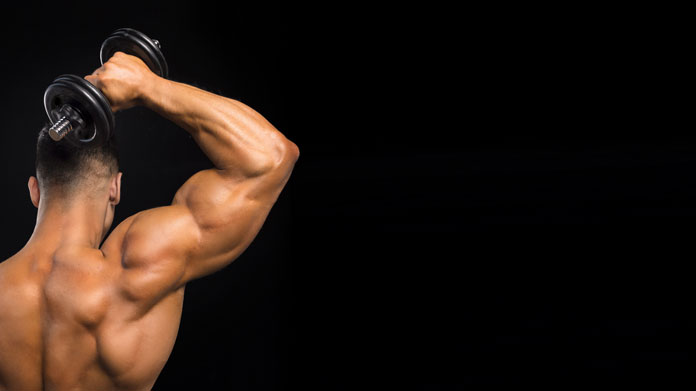
Target muscles: Arm Extensor, Knobius
The overhead tricep press is one of the dumbbell exercises that require good body stability and body awareness. You sit on a weight bench and, equipped with a dumbbell, stretch one arm vertically over your head. The elbow points outwards during the stretch and the knuckles point towards the ceiling.
The other arm can stabilize the “training arm” in position. The spine and head are upright or the head is facing forward. The dumbbell is moved down in a controlled manner by bending your arm and catapulting back up a little faster. The movement takes place mainly through your forearm.
Variation: When standing or lying down, additional auxiliary muscles are activated, which intensify the exercise.
Dumbbell Concentration Curls
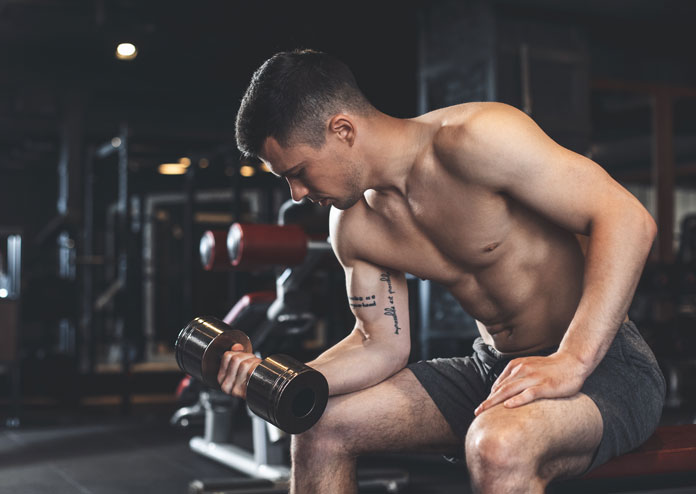
Target muscles: biceps, humerus
Concentration curls are one of the dumbbell exercises that focus heavily on the arm flexors. You sit a little more than shoulder-width apart on a flat bench. A dumbbell is taken in the underhand grip and the arm is fixed to the corresponding leg with the elbow.
Now bend your arm from the stretched position into a slightly acute angle so that maximum tension can be felt in the crooked arm area. It is best to hold this bending position under tension for a moment. Finally, bring your arm back into the almost extended position.
Variation: Concentration curls offer a slight deflection of the bending and stretching movement, e.g. B. by shorter or different fast movements, on the one hand, to increase the training stimulus and on the other hand to stimulate the flexor muscles to the maximum.
Dumbbell Lunges
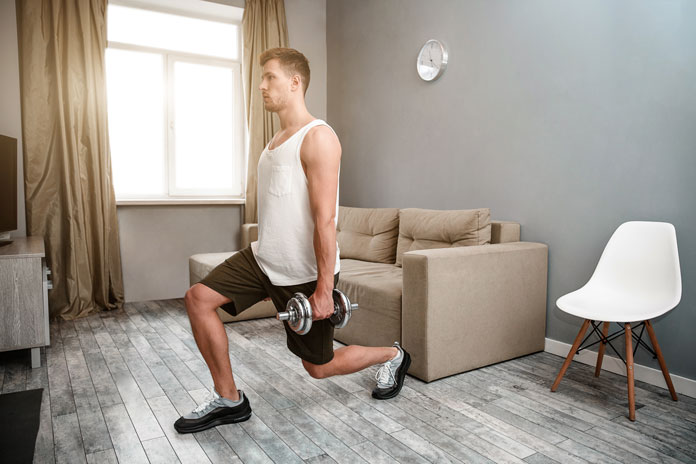
Target muscles: Entire muscles of arms, Gluteus Maximus, Quadriceps
Lunges or lunges are actually dumbbell exercises that are used to train the leg muscles or leg strength. However, they can be great for arm hypertrophy by statically engaging the arm muscles. Hold a dumbbell in each hand. Stand hip-width apart and take a moderate lunge forward.
Your upper body remains as upright and stable as possible, your arms remain stretched and the front knee points forward like the toes. Now you come back to the standing position and then switch legs with the next lunge under the same conditions.
Variation: The basic movement of the lunge remains the same, but you combine e.g. In the standing position, this exercise with a hammer or bicep curl. The integration of shoulder presses and tricep presses would also be conceivable to increase the training stimulus on the arm muscles.

